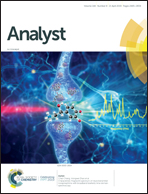Fluorescence signal amplification assay for the detection of B. melitensis 16M, based on peptide-mediated magnetic separation technology and a AuNP-mediated bio-barcode assembled by quantum dot technology
Abstract
Members of the Brucella spp. are facultative intracellular bacteria that can cause global brucellosis, a zoonotic disease. Herein, a novel fluorescence signal amplification (FSA) method for the rapid detection of B. melitensis 16M was developed based on peptide-mediated magnetic separation (PMS) technology and Au nanoparticle (AuNP)-mediated bio-barcode assay technology assembled by quantum dots (QDs). The PMS technology was used to specifically capture and isolate B. melitensis 16M from food. The immunomagnetic bead-B. melitensis 16M bioconjugates (IMBs-B. melitensis 16M) were then identified by IgY on the surface of AuNPs and the oligonucleotide chains on the surface of the gold nanoparticles were hybridized with bio-barcodes assembled by quantum dots (QD-probe2). The IMB/B. melitensis 16M/IgY–AuNP-probe1/QD-probe2 bioconjugates were concentrated by magnetic separation. Therefore, as the concentration of B. melitensis 16M in the sample increased, the unbound QD-probe2 in the supernatant reduced, and the B. melitensis 16M in the sample could be indirectly measured by detecting the fluorescence in the supernatant. This FSA method can detect B. melitensis 16M concentration in the range of 10 to 106 cfu ml−1 without pre-enrichment, and the limit of detection (LOD) is as low as 10 cfu ml−1 with high specificity. Furthermore, the proposed method for the detection of B. melitensis 16M has a LOD of 1.07 × 102 cfu ml−1 and a linear range from 102 to 107 cfu ml−1 in milk, and a LOD of 1.72 × 102 cfu ml−1, and a linear range from 102 to 106 cfu ml−1 in lamb leach. In addition, this method takes less than 3 h to perform. Thus, the assay that was developed in this study shows promise for rapid, sensitive, and specific detection of B. melitensis 16M.



 Please wait while we load your content...
Please wait while we load your content...